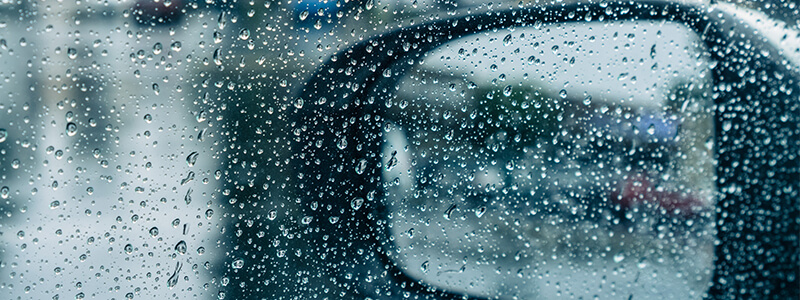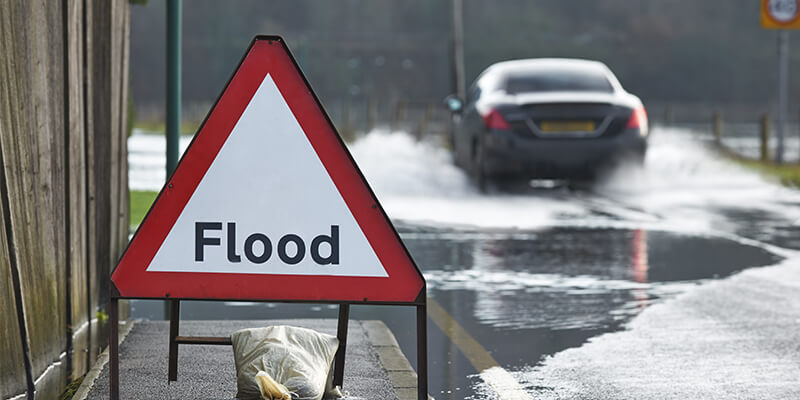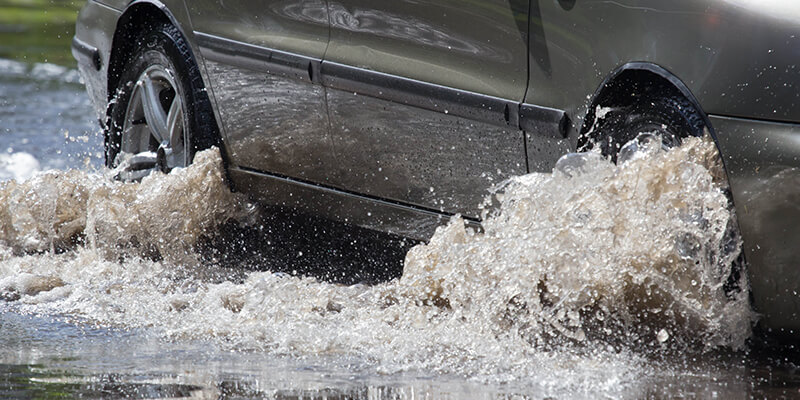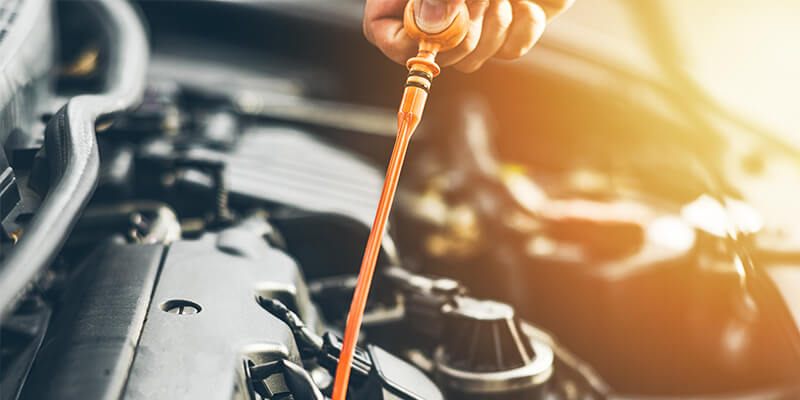Living in the UK, wet weather may seem like a non-event. However, it can cause danger and serious hazards on the roads. Every driver must be aware of how to stay safe in wet road conditions, whether it be heavy rain, puddles or flooding.
This is why we have created this guide on driving in wet weather conditions. In it, we cover everything you need to know about driving in the rain and flooding, including the following:
- Tips for driving in the rain
- Why does the stopping distance increase in the rain?
- What is aquaplaning?
- What happens if there is heavy rain on your test?
- Preparing for driving in the rain/floods
- Watching out for hazards in floodwater
- Driving through water and flooding
- Can I drive through a flood in an electric car?
- What to do if you break down during flooding
- Checks to do after driving through water
Tips for driving in the rain
Driving in the rain is a regular task you will experience as a driver, but along with heavy rain comes many different dangers. The most dangerous time to drive in wet conditions is the moment it starts to rain. This is because any oil or residue on the road will immediately become slippery and could cause you to spin out.
Regardless of what vehicle or wheels you have, it will most definitely be affected by wet roads. For this reason, it is important to adjust your driving when there are large puddles and heavy rain, taking extra care.
Here are our top tips on how to drive in the rain:
- If it is raining before you set off, always check your windscreen wipers are in full working condition before you set off. They will be essential for visibility on your journey.
- Turn on your dipped headlights. Rain often causes the sky to become dark and dismal, reducing visibility. Turning on dipped headlights to ensure other drivers can see you easily. Do not use your rear fog lights, as this can mask your brake lights and dazzle the drivers behind you.
- Keep an extra distance from large vehicles such as lorries; they could cause spray which will limit your visibility.
- Watch out for pedestrians and cyclists; heavy rain makes it harder to notice pedestrians and cyclists on the side of the road or at pedestrian crossings, so always make it a routine to check all mirrors and your blind spot.
- Slow down more and take extra care when approaching a junction or taking on tight turns to avoid spinning out.
- If steering starts to feel out of your control, ease off your acceleration and brake slowly and gradually. Never make any sudden braking movements – unresponsive steering is an indication that your tyres are losing grip.
- Look out for oil on the road. Rain settling on top of oil will create a huge skid hazard.
- Avoid big puddles; they could be disguising a pothole.
- Rain causes your windscreen to steam up, so always keep the air conditioning on to avoid losing your primary source of visibility.
- Driving too fast over standing water could cause aquaplaning, which will make you lose full control of your car. If your steering suddenly feels light or you feel your car moving to one side, then ease off the accelerator, do not touch the brakes, and allow the vehicle to slow down until you gain back control. Serious and extremely expensive damage can be caused if you are to drive too fast through standing water.
- If you do happen to break down, then make sure that you step well away from the vehicle and leave the bonnet closed until help arrives. Leaving the bonnet open in a downpour could potentially soak and damage the electrical system.
- Your stopping distance is significantly increased when the roads are either wet or icy. It is important that you slow down, leave at least 8 seconds between the driver in front, and brake earlier when approaching junctions and roundabouts.

Why does the stopping distance increase in the rain?
To keep tyres gripped safely onto the road surface, there needs to be a considerable amount of friction between the two. During rainfall, water will either create a layer on top of the road or run like a stream down its surface, both of which reduce friction, increasing the likelihood of skidding.
Your stopping distance will vary depending on the speed you are driving at. Wet road surfaces cause stopping distances to increase by more than double the amount required when driving on a dry surface. The general rule is that on a dry day, you must leave at least a two-second time gap between you and the car in front, meaning that in wet conditions this must be increased to four seconds or more depending on the severity of the rain.
Here are some examples of different speeds along with their stopping distance:
Remember: these measurements will be at least doubled when driving in the rain.
The above table is from the Highway Code.
What is aquaplaning?
Aquaplaning is when heavy rain builds up between a vehicle’s tyres and the road resulting in a loss of grip and control when you drive. When you aquaplane, you cannot steer, accelerate or brake effectively.
Tyres are designed to displace water on the road by funnelling it through the grooves in their tread. However, if a vehicle is driving through the water faster than the tyres can displace it, a layer of water builds up between the road and the tyre; it is like the vehicle is floating on the water. In this state, there is no friction, no grip and no control for the driver.
If your engine starts to sound louder and the steering becomes light, it is a massive indication that your vehicle is aquaplaning. Always remain calm in this situation. You will need to slowly ease off the accelerator, and only when you feel the car slowing down can you start to brake gently. Keep your steering wheel straight and don’t try to steer in different directions.
What happens if there is heavy rain on your test?
If the rain is heavy enough to cause flooding it will be considered a dangerous weather condition and your driving test will not go ahead. If you are unsure whether your test may be cancelled, you must call your test centre on the day, an hour or so before you are scheduled to take your test. A heavy downpour often stops after a short amount of time, meaning that if the rain clears, you will likely still be able to take your test unless there is severe flooding in your local area.

We spoke to Chris Cochrane who teaches in Milton Keynes and Buckingham, about his opinion on teaching in the rain and any advice he has on the subject. He said, “Of course, if the weather conditions could run the risk of danger to my pupils I will not carry out a driving lesson. I teach many pupils in Buckingham, which has many country roads which often flood, meaning lessons can’t take place. However, I believe it’s important for learners to have at least one of their driving lessons in the rain. Without practice, many people panic when faced with driving in heavy rain and sometimes it’s an unavoidable situation. My best advice is to stay calm and take your time; no one will rush you and your safety, along with other drivers’ safety, is most important. I can guarantee that once you have conquered the task once, you’ll wonder why you ever worried!”
Preparing for driving in the rain/floods
A heavy downpour can very easily transform into a flood, or a burst pipe can cause your everyday route to become congested and dangerous to drive on. Knowing how to drive in floodwater is an essential part of maintaining safety on the roads.
The first thing you should think about is whether the journey is essential. We would always advise that you remain indoors and off the roads when there is severe flooding, and seriously think about delaying your journey until the weather subsides. However, we know it can be hard to predict the rain, and when you have to go to and from work, it’s almost impossible to avoid driving.
Make sure that you tick all of the boxes on our checklist before starting your journey:
- Plan and research your route. Check the news for flood warnings and road closures, ensuring that you take the safest road possible.
- Factor in extra time for your journey. It is very likely that it will take you much longer to get to your destination when driving safely. Accidents may occur, unexpected road closures can spring up and you will have to drive slowly to ensure that you do not cause a collision, all of which will double the time it usually takes to get from one place to another.
- Make sure your your windscreen wipers are working effectively, and get them replaced if not.
- Fill up with fuel before you start your journey – getting stuck in traffic will increase your fuel consumption, and you don’t want to get stuck out in the rain.
- Always have your phone in the vehicle.
- Take some snacks and drinks.
- Check that your tyres are the legal tyre tread depth.
- Pop a coat or blanket into the boot in case your vehicle breaks down.
- Let friends or family know where you are heading and when you get there; this allows them to keep track of your whereabouts in case you have an accident.
Watching out for hazards in floodwater
Potential hazards are hard to see when there is flooding on the road. Things become invisible, and danger is significantly increased. The kerb on the side of the road can be hidden underneath the water, making it hard to gauge where the side of the road is. This often causes drivers to damage their alloys or swerve to the other side of the road. Other hazards that can cause damage are unexpected potholes or even manholes where the lid has been lifted and moved with the water.
Floodwater is often also contaminated. If you are located in urban areas, then floodwater may potentially carry harmful bacteria which can cause diseases. If you are in a rural area, agricultural chemicals and animal waste can find their way into the water, both of which are incredibly harmful. If you break down, always ensure that you are far from flooding for health and safety reasons.
Driving through water and flooding
Whether it is a small puddle or a large flood, there are severe dangers that come along with driving through water. Do not drive through flooded water if at all possible. However, if it is unavoidable and safe to do so, here are some tips for driving through floodwater:
- Find out how deep the water really is, even if it means popping on your hazards and getting out of the vehicle to find out. If the water is muddy, grab a stick to try and find the lowest point for you to drive through. Remember, just because one car can cross, doesn’t mean that yours can.
- If the water is too deep, then find another way to get to your destination. Do not risk driving through the flood, as this can severely damage your vehicle and you could potentially get stuck.
- If you can drive through the puddle or flood, then make sure that there are no obstacles or hazards in the way that may cause damage to your vehicle.
- To drive through the flood, place your car in second gear and keep the revs up; this will help you to keep the momentum of your vehicle.
- Once you have got to the other side, stop your car for a few moments to make sure that all of the excess water drips off the vehicle.
- Be aware that the grip level of the road ahead will be reduced, as the water is pulled across the tarmac by other drivers.
- As you pull away, drive carefully and slowly, gently tapping the brake pads to allow friction to create heat to evaporate water on them.
Can I drive through a flood in an electric car?
Electric cars are waterproof and just as safe as their petrol/hybrid counterparts. Nevertheless, just like other vehicles, they are not designed to be submerged in water. Water can break through seals and parts and damage the internal systems of the car. Driving through deep standing water is a risk so it is important to assess the situation properly before making a decision to drive through flooding in any vehicle.
What to do if you break down during flooding
In some unfortunate cases, vehicles do break down during flooding, and it can be both inconvenient and dangerous. If this happens always keep your bonnet closed and stay away from any floodwater as it may be contaminated.
If your engine stops after you have driven through deep water, then it is important to make sure that you DO NOT try to restart it. Doing this could cause further, more expensive damage. Water could be sucked up into the engine, causing it to lock up; this will result in a full engine replacement. Instead, turn on your hazard lights, call for help and allow a professional to examine the car before driving off.
One of our reputable instructors providing driving lessons in Northampton, had this to say about breaking down during flooding:
“The first thing to remember is never to panic; stay calm. These things happen, and it’s why it is important to make sure that you have all of the gear and knowledge to stay safe. I would always advise students to seek help and never attempt to repair the car or start the engine unless they know what they are doing. Always contact someone to let them know of your whereabouts and what is going on, as your safety is of the utmost importance.”
Checks to do after driving through water
After driving through water, you should check your vehicle is still safe to drive. These checks can easily be completed either while you are driving slowly, or immediately after driving through water. Some of the most important parts to check include the following:
- Brakes – Tap on your brakes to make sure that they don’t slip, ensuring that you have a sufficient grip.
- Engine – Observe how your engine behaves after driving through water, as there may be problems that could cause severe damage. Try checking the following:
- Oil dipstick – If water has found its way into the engine via air intake, then water droplets may be visible on your dipstick.
- Air filter – The filter or airbox may be wet if water has come through the air intake, and can cause further damage if you continue driving.
- Mill – If water has found its way into the mill, then this is extremely serious as it can cause the engine to fail. Make sure that you have your engine professionally checked and the oil changed.
- Electrical and electronics – Most modern cars have water-resistant electrical connectors, but moisture can still enter and cause shorting. Inspect the fusebox, and if damaged, try to locate the damage and have it replaced immediately.
- Carpeting – Flood water could enter the undercarriage, causing your carpet to become wet. Do not let the water sit in the interior, as this can create rusting, mould and a bad smell. Wipe down and dry the interior before placing the mats back down.
- Spare tyre area – If water has entered this area, then dry it out to avoid rusting.
Water-safe driving
Water makes driving dangerous so it is important to take your safety seriously and ensure that you are familiar with all of the tips above. By being fully prepared for wet road conditions, you not only keep yourself safe but also protecting your vehicle and other road users from being involved in an accident. However, if the road conditions are wet and slippy, we would always first and foremost recommend staying in – wet weather is always better to experience indoors in the warm and dry!










